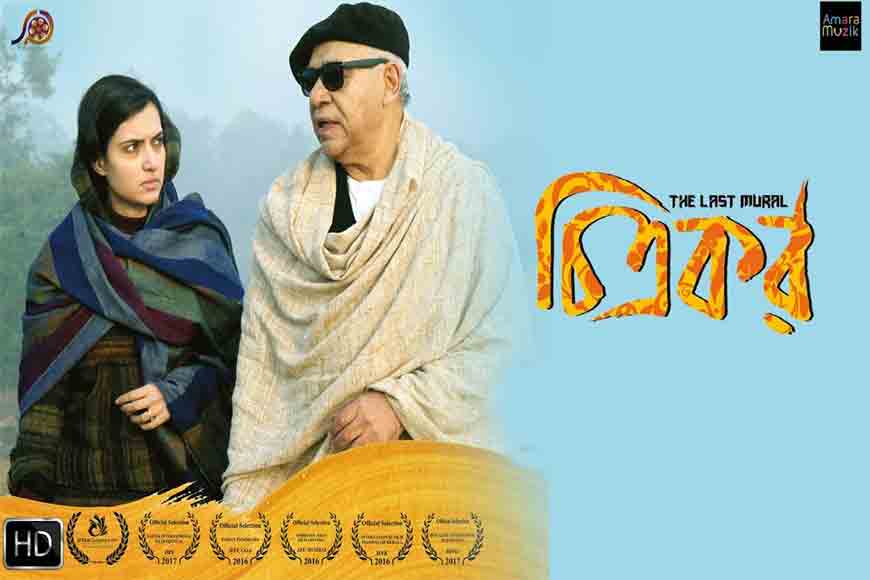Which blind artist inspired Saibal Mitra’s Chitrokor?

Journalist Shuvra Dey dissects Saibal Mitra’s Chitrokor – Last Mural and discovers the heart-wrenching story of eternal strife of Art vs Commerce

Saibal Mitra’s latest offering on celluloid, Chitrokor – Last Mural was released recently. Written and directed by Mitra, the very title of the movie fits like pieces of a jigsaw puzzle and reminds the audience of two great artists: Binod Behari Mukhopadhyay and Mark Rothko. In fact, the film is inspired by the similar cerebral world they sharedespite the vast social and geographical chasm that separates them. It is sort of a cinematic tribute to these two great contemporary creators from different parts of the globe -- Benod Behari, from Bengal and Rothko from New York.
Binod Behari was one of the pioneers of Indian modern art and one of the earliest artists of India to use murals as an art form. During his years as teacher at Kala Bhavana, he inspired his students, many of whom later became celebrated artists, including Jahar Dasgupta, K.G. Subramanyan, sculptor and printmaker Somnath Hore, designer Riten Majumdar and filmmaker Satyajit Ray. This was Binod Behari’s most creative phase as he painted and sculpted simultaneously. But he lost his eyesight completely in 1956 at the age of 52. This could in no way diminish his creative urge. Directing himself into new areas and drawing upon his inner resources, he started making drawings and small sculptures, based upon figural images he made by folding papers. Thus, his ‘inner vision’ led him the way.

Binod Behari’s disciple Satyajit Ray, considered him his mentor and inspiration. He was bowled over by Binod Behari’s paper cut works titled The Inner Eye. In 1973 Ray made a documentary on the works of Bindo Behari. This documentary was instrumental in bringing the works of Binod Behari to a wider audience.After losing his eyesight, he ventured into the world of letters, taking to writing more seriously than ever before. He wrote about his experiences, history of art education, and a series of incisive studies. The book that brought him fame as a writer in Bengali was Chitrakor, published in 1979, a collection of autobiographical pieces. Chitrakor was landmark work of literature that won two awards in 1980, namely the Rabindra Puraskar and the Bhartiya Bhasha Parishad Award.
Born in Dvinsk, Russia (in what is now Latvia), Marcus Rothkovich aka Mark Rothko was someone with whom Binod Behari’s story could be related. A prominent figure among the New York School painters, he moved through many artistic styles until reaching his signature 1950s motif of soft, rectangular forms, floating on a stained field of color. Heavily influenced by mythology and philosophy, he was insistent that his art was filled with content. A fierce champion of social revolutionary thoughts, and the right to self-expression, Rothko also expounded his views in numerous essays and critical reviews.
He strongly believed inan artist’s total freedom of expression, which he felt was compromised by the market. This belief often put him at odds with the art world establishment, leading him to publicly respond to critics, and occasionally refuse commissions, sales and exhibitions.
The Four Seasons Restaurant is one of the swankiest places to have a meal in New York- so swanky that Mark Rothko decided he didn’t want his paintings hung there. Rothko’s Seagram Murals were commissioned by the Mies van der Rohe and Philip Johnson designed restaurant before it opened in 1959. Rothko being the spit fire he was, accepted the commission but later, the painter was so disgusted by the pretentious air in the Four Seasons, that he decided to pull the paintings all together. The pieces now hang at London’s Tate Gallery, Japan’s Kawamura Memorial Museum and the National Gallery of Art in Washington, D.C.
The creative eye goes deeper than the mechanics of eyesight. Saibal Mitra’s Chitrokor – Last Mural depicts blind artist Bijon Bose, who spent much of his life inspiring students by bringing stories to life through his paintings and idealism. His life is interrupted by a proposal to create a mural for an exclusive restaurant in Kolkata, a journey that brings young, independent contemporary painter Tithi into his life. Their relationship unfolds through the lines of the mural, as they struggle between generations and philosophies. Bijon’s once-clear lines of artistic integrity are troubled by Tithi’s realism, as he grapples with his role and responsibility towards the entire gamut of his work beyond the brush.

Bijon seeks answers: For whom does a painter paint? Is it for them who have monetary power to buy anything they fancy? When does an artist’s creation turn into a commodity? Chitrokor – Last Mural presents this tension, between art andmarket and how a market-driven world tramplesidealism and cerebral instincts, dragging everything to mediocrity.










